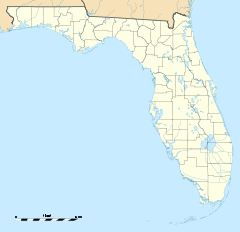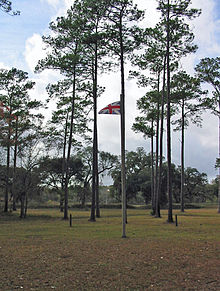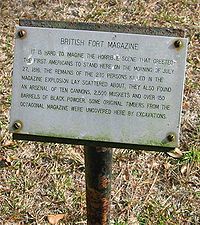- Fort Gadsden
-
British Fort
 Remains of Fort Gadsden.
Remains of Fort Gadsden.Location: Franklin County, Florida Nearest city: Sumatra Coordinates: 29°56′N 85°1′W / 29.93333°N 85.01667°WCoordinates: 29°56′N 85°1′W / 29.93333°N 85.01667°W Governing body: United States Forest Service NRHP Reference#: 72000318[1] Significant dates Added to NRHP: February 23, 1972 Designated NHL: February 23, 1972[2] Fort Gadsden is located in Franklin County, Florida, on the Apalachicola River. The site contains the ruins of two forts, and has been known by several other names at various times, including Prospect Bluff Fort, Nichol's Fort, British Post,[3] Negro Fort, African Fort, and Fort Apalachicola.
Listed in the National Register of Historic Places, the Fort Gadsden Historic Site is located in Apalachicola National Forest and is managed by the U.S. Forest Service. It was named a National Historic Landmark in 1972.[2]
Contents
Original fort
During the War of 1812, the British hoped to recruit the Seminole Indians as allies in their war against the United States. In August 1814, a force of over 100 officers and men led by a lieutenant colonel of Royal Marines, Edward Nicolls, was sent into the Apalachicola River region in Spanish Florida, where they began to aid and train local Indians. Although Nicolls claimed he rallied large numbers of Indians, his efforts bore little fruit in terms of actual fighting, and the completion of the war ended his mission a few months after his arrival.
Before Nicolls left, however, he built a fort at Prospect Bluff, 15 miles above the mouth of the Apalachicola and sixty miles below U.S. territory, which he equipped with cannon, guns, and ammunition. The fort, originally known as the British Post, served as a base for British troops and for recruitment of ex-slaves into the new Corps of Colonial Marines, and as a rallying point to encourage the local Seminole Indian tribes to attack the United States. When the British evacuated Florida in the spring of 1815, they left the well-constructed and fully armed fort on the Apalachicola River in the hands of their allies, about 300 fugitive slaves, including members of the disbanded Corps of Colonial Marines, and 30 Seminole and Choctaw Indians. News of the "Negro Fort" (as it came to be called) attracted as many as 800 black fugitives who settled in the surrounding area.
Under the command of a black man named Garson and a Choctaw chief (whose name is unknown), the inhabitants of Negro Fort launched raids across the Georgia border. The fort, located as it was near the U.S. border, was seen as a threat to Southern slavery. The U.S. considered it "a center of hostility and above all a threat to the security of their slaves."[4] The Savannah Journal wrote of it:
It was not to be expected, that an establishment so pernicious to the Southern States, holding out to a part of their population temptations to insubordination, would have been suffered to exist after the close of the war. In the course of last winter, several slaves from this neighborhood fled to that fort; others have lately gone from Tennessee and the Mississippi Territory. How long shall this evil, requiring immediate remedy, be permitted to exist?[5]
Seminole Wars
Main article: Battle of Negro FortIn early 1816 the U.S. built Fort Scott on the west bank of the Flint River in Georgia for the purpose of guarding the Spanish-American border. Supplying the fort, however, was a problem; to take materials overland required traveling through unsettled wilderness. Major General Andrew Jackson, the military commander of the southern district, preferred supplying Fort Scott by boat over the Apalachicola River in Spanish territory, which had the advantages of being both easier and of providing a likely casus belli for destroying the Negro Fort. As expected, when a naval force attempted the passage on July 17, 1816, it was fired on by the Negro Fort, and four U. S. soldiers were killed.[6]
Ten days later, Andrew Jackson ordered Brigadier General Edmund P. Gaines at Fort Scott to destroy the Negro Fort. The American expedition included Creek Indians from Coweta, who were induced to join by the promise that they would get what they could salvage from the fort if they helped in its capture. On July 27, 1816, following a series of skirmishes, the American forces and their Creek allies launched an all-out attack under the command of Lieutenant Colonel Duncan Clinch, with support from a naval convoy commanded by Sailing Master Jarius Loomis.
The two sides exchanged cannon fire, but the shots of the inexperienced black gunners failed to hit their targets. A "hot shot" (a cannonball heated to a red glow) from the American forces entered the opening to the fort's powder magazine, igniting an explosion that was heard more than 100 miles (160 km) away in Pensacola, and destroyed the fort, killing all but 30 of 300 occupants.[7] Garson and the Choctaw chief, among the few who survived the carnage, were handed over to the Creeks, who "Scalped the Choctaw alive and then fatally stabbed him; Garson was shot in execution style."[who?] Other survivors were returned to slavery.
The Creeks salvaged 2,500 muskets, 50 carbines, 400 pistols, and 500 swords from the ruins of the fort, increasing their power in the region. The Seminoles, who had fought with the blacks, were conversely weakened by the loss of their allies, and Creek involvement in the attack increased tension between the two tribes.[8] Seminole anger at the Americans for the fort's destruction would contribute to the breakout of the First Seminole War a year later.[9]
Spain protested the violation of its soil, but according to historian John K. Mahon, it "lacked the power to do more."[10]
Rebuilt fort
In 1818 General Jackson directed Lieutenant James Gadsden to rebuild the fort, which he did on a nearby site. Jackson was so pleased with the result that he named the location Fort Gadsden.
During the American Civil War, Confederate troops occupied the fort until July 1863, when an outbreak of malaria forced its abandonment.
See also
Notes
- ^ "National Register of Historical Places - Florida (FL), Franklin County". National Register of Historic Places. National Park Service. 2007-09-22. http://www.nationalregisterofhistoricplaces.com/FL/Franklin/state.html.
- ^ a b British Fort at National Historic Landmarks Program
- ^ Life of Andrew Jackson. James Parton, Houghton, Mifflin and Company, 1880. p. 393. [1]
- ^ Mahon, History of the Second Seminole War, pg. 23.
- ^ Savannah Journal, June 26, 1816, quoted in Aptheker, American Negro Slave Revolts, pg. 31.
- ^ Casualties: U. S. Navy and Marine Corps Personnel Killed and Wounded in Wars, Conflicts, Terrorist Acts, and Other Hostile Incidents, Naval Historical Center, United States Navy.
- ^ Aptheker, 259.
- ^ Mahon, 23.
- ^ Mahon, 24.
- ^ Mahon, 23-24.
References
- Robert V. Remini, Andrew Jackson and his Indian Wars. Viking Penguin, 2001.
- Mark F Boyd, "Events at Prospect Bluff on the Apalachicola River, 1808-1818". Florida Historical Quarterly No.16 (1937).
- Benjamin W. Griffith, Jr., McIntosh and Weatherford Creek Indian Leaders. The University of Alabama Press, 2005 (Page 176)
- Herbert Aptheker. American Negro Slave Revolts. 5th edition. New York, NY: International Publishers, 1983 (1943).
- John K. Mahon. History of the Second Seminole War. 2nd revised edition. Gainesville, FL: University of Florida Press, 1985 (1967).
Further reading
- Skip Horack. The Eden Hunter, Counterpoint, 2010. (A novel inspired by the assault on the Negro Fort.)
External links
 Media related to Fort Gadsden at Wikimedia Commons
Media related to Fort Gadsden at Wikimedia Commons- Fort Gadsden Historic Site - official site at Apalachicola National Forest
- Fort Gadsden and the "Negro Fort" at exploresouthernhistory.com.
- Map to Fort Gadsden
- Negro Fort, 8 Story Panels with Pictures narrating the attack on the fort in 1816, from the documentary site Rebellion: John Horse and the Black Seminoles
- Negro Fort at Ghost Towns
- Fort Gadsden at American Forts Network
- The First Emancipation Proclamation at Daily Kos
U.S. National Register of Historic Places in Florida Lists by county Alachua • Baker • Bay • Bradford • Brevard • Broward • Calhoun • Charlotte • Citrus • Clay • Collier • Columbia • DeSoto • Dixie • Duval • Escambia • Flagler • Franklin • Gadsden • Gilchrist • Glades • Gulf • Hamilton • Hardee • Hendry • Hernando • Highlands • Hillsborough • Holmes • Indian River • Jackson • Jefferson • Lafayette • Lake • Lee • Leon • Levy • Liberty • Madison • Manatee • Marion • Martin • Miami-Dade • Monroe • Nassau • Okaloosa • Okeechobee • Orange • Osceola • Palm Beach • Pasco • Pinellas • Polk • Putnam • Santa Rosa • Sarasota • Seminole • St. Johns • St. Lucie • Sumter • Suwannee • Taylor • Union • Volusia • Wakulla • Walton • Washington

Lists by city Other lists Keeper of the Register • History of the National Register of Historic Places • Property types • Historic district • Contributing property Categories:- Andrew Jackson
- National Historic Landmarks in Florida
- Black Seminoles
- Florida in the American Civil War
- American Civil War forts in Florida
- Seminole Wars
- 1816 in the United States
- Ghost towns in Florida
- History of the United States (1789–1849)
- Slavery in the United States
- Protected areas of Franklin County, Florida
- British forts in the United States
- Colonial forts in Florida
- Historic Florida architecture 1989 AIA survey listings in Franklin County
- Fort Gadsden
Wikimedia Foundation. 2010.




